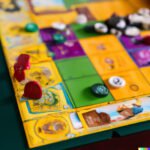When it comes to board games, there’s something special about playing against a single opponent, engaging in the timeless battle of wits and strategy. Two-player board games have stood the test of time, captivating players with their intimate and interactive nature.
Whether you’re outsmarting your opponent in Chess or vying for word domination in Scrabble, these classic games offer endless hours of entertainment. In recent years, there has been a revival of interest in traditional board games, as people rediscover the joy of face-to-face competition and bonding over a shared experience.
The appeal of two-player board games lies not only in their gameplay mechanics but also in the social aspect they offer. These games create a unique opportunity for close interaction and connection between players.
The back-and-forth nature of the game, paired with direct competition against a single opponent, makes each move feel significant and thrilling. The tension builds as players strategize and adapt to their opponent’s moves, fostering an immersive experience that can easily draw players into the game for hours on end.
In an era where digital forms of entertainment dominate our lives, it is refreshing to see a resurgence in interest towards classic board games. Two-player board games offer a break from screens and bring people together in a tangible way.
From millennials seeking nostalgic experiences to families looking for meaningful bonding activities, these timeless classics hold immense charm for all age groups. So dust off that old chessboard or grab your favorite word tiles because it’s time to embark on an adventure through the world of two-player board games.
Brief History of Two Player Board Games
Two-player board games have a rich and vibrant history that spans centuries. These classic games have provided entertainment and challenges for people throughout time, with their enduring popularity standing as a testament to their timeless appeal.
The origins of two-player board games can be traced back to ancient civilizations. Games like Chess and Backgammon, which are still played today, were enjoyed by emperors, kings, and commoners alike in ancient India, Persia, China, and Egypt. These early versions of the games may have varied in rules and design, but they laid the foundation for the strategic gameplay that players enjoy today.
Over the centuries, these two-player board games evolved and adapted to different cultures and regions. For example, Chess spread to Europe during the Middle Ages, where it underwent changes in its rules and pieces. It became a symbol of intellectual prowess and strategic thinking among nobility. On the other hand, Backgammon found its way into Europe through trade routes from the Middle East. Its blend of luck and strategy captured the interest of players across social classes.
Despite being rooted in ancient times, these classic two-player board games continue to captivate players worldwide in their modern forms. The Chess we know today is played at international competitions watched by millions around the globe. Backgammon has also maintained its popularity with dedicated tournaments featuring some of the best players in the world.
Chess
Chess is often regarded as the ultimate classic two-player board game due to its timeless appeal and strategic depth. Originating from India in the 6th century, Chess has evolved and gained recognition worldwide as a game of skill and intellect. It is played on a square board with 64 squares of alternating colors, each player starting with 16 pieces including kings, queens, knights, and pawns.
One of the key reasons for Chess’s enduring popularity is its strategic complexity. The game requires players to think several moves ahead, anticipate their opponent’s moves, and make calculated decisions based on position and future possibilities. With millions of possible positions and an immense number of potential moves for each turn, Chess offers endless opportunities for exploration and improvement.
Chess also possesses a universal appeal that transcends cultures and languages. It has been embraced by individuals from all walks of life, from amateurs playing casually at home to grandmasters competing in prestigious tournaments. The highest level of competitive Chess is governed by international organizations such as FIDE (Fédération Internationale des Échecs), which oversees world championships and maintains chess rankings.
Given its long history and global recognition, Chess has developed various styles and variations over time. Some popular variations include blitz chess (fast-paced games with limited time per player), bullet chess (extremely fast-paced games with only a few seconds per player), and correspondence chess (games played via mail or online platforms over an extended period).
| Number of Possible Positions | Estimated Number |
|---|---|
| Number of Possible Games at Move 40 | 10^120 |
| Highest Official FIDE Elo Rating | 2882 (Magnus Carlsen in 2014) |
| Number of Moves Considered “Perfect” | Zero (according to current knowledge) |
Chess continues to captivate players of all ages and skill levels, providing a platform for intellectual challenge, social interaction, and friendly competition. Whether it is played casually with friends or pursued at a competitive level, Chess remains the ultimate classic two-player board game for those seeking mental stimulation, strategic thinking, and the thrill of outsmarting their opponent.
Backgammon
Backgammon is a classic two-player board game that has been enjoyed for centuries. Its origins can be traced back to ancient civilizations such as Mesopotamia, where it was played on a board with dice-like tools made from animal bones. Throughout history, Backgammon has evolved and gained popularity across the globe.
One of the unique aspects of Backgammon is the combination of strategy and luck involved in gameplay. Players must strategically move their pieces across the board based on the roll of the dice, while also making tactical decisions to block their opponent’s moves or create opportunities for themselves. This element of chance adds an exciting and unpredictable aspect to the game, making each match different from the last.
The addictive nature of Backgammon can be attributed to its simple rules and endless possibilities for strategic play. Players must constantly analyze the board, anticipate their opponent’s moves, and make calculated decisions to gain an advantage. The game offers a balance between skill and chance, ensuring that even experienced players are challenged and engaged.
Notable Backgammon players have emerged throughout history, some even achieving legendary status in the world of competitive gaming. Tournaments are held worldwide where players face off against each other in intense matches that showcase their skills and strategic thinking. These tournaments often attract a dedicated following who appreciate the thrilling nature of Backgammon as both a recreational pastime and a competitive sport.
Scrabble
Scrabble is a beloved classic two-player board game that has stood the test of time. With its unique blend of word creation, strategy, and competition, Scrabble continues to captivate players of all ages. In this section, we will explore the enduring popularity of Scrabble, discuss the challenge of creating words and strategizing, highlight the educational benefits it provides, and mention famous Scrabble players and tournaments.
The Enduring Popularity of Scrabble
Scrabble has remained a popular choice among board game enthusiasts for decades. Its simple yet engaging gameplay appeals to both casual players and seasoned word nerds alike. The addictive nature of trying to create high-scoring words using limited resources keeps players coming back for more. Additionally, its accessibility makes it suitable for players of various skill levels, ensuring that everyone can enjoy a good game.
The Challenge of Creating Words and Strategizing
One of the key aspects that makes Scrabble so appealing is the challenge it presents in creating words and strategizing your moves. Players must carefully consider their options with each turn by considering letter values and positioning their tiles strategically on the board. This requires not only a strong vocabulary but also strategic thinking to maximize scores while preventing opponents from scoring big.
Educational Benefits of Playing Scrabble
Apart from being an enjoyable pastime, playing Scrabble also offers numerous educational benefits. It helps improve vocabulary by exposing players to new words and challenging them to expand their linguistic knowledge. Furthermore, Scrabble enhances spelling skills as players have to ensure correct word formation. Its competitive nature fosters quick thinking and decision making under pressure. Thus, whether played casually or as part of an educational activity, Scrabble promotes learning in an engaging way.
Famous Scrabble Players and Tournaments
Over the years, many individuals have become renowned for their skills in playing Scrabble competitively. One notable player is Nigel Richards, who has won multiple national and international Scrabble championships. His exceptional word knowledge and strategic gameplay have made him a force to be reckoned with in the Scrabble community.
Additionally, there are various Scrabble tournaments held worldwide that attract skilled players from different corners of the globe. These competitive events showcase the talent and dedication exhibited by players in their pursuit of Scrabble excellence.
Scrabble continues to entertain and challenge generations of players with its unique combination of language skills, strategy, and friendly competition. Whether played casually or competitively, this classic two-player board game remains a favorite choice for those looking for a mentally stimulating and enjoyable experience. So gather your tiles, put your thinking caps on, and embark on an exciting word-building adventure with Scrabble.
Stratego
Stratego is a classic two-player board game that has captured the hearts and minds of players for decades. It is a game that combines elements of strategy, deception, and suspense, making it an exciting and engaging experience. This section will delve into the appeal of Stratego, discussing the thrill of outsmarting your opponent, highlighting the suspenseful gameplay and hidden information, and exploring different strategies and approaches.
One of the main factors contributing to the appeal of Stratego is the thrill of outsmarting your opponent. The game revolves around planning and executing strategic moves while simultaneously trying to deduce your opponent’s strategy.
Players must carefully position their pieces on the board, creating a hierarchy of power while maintaining secrecy about the identity of each piece. The element of deception adds an extra layer of excitement as players try to mislead their opponents while uncovering their true intentions.
The gameplay in Stratego is inherently suspenseful due to the hidden nature of each player’s pieces. With only limited knowledge about the abilities and ranks of the opponent’s pieces, every move becomes a calculated risk. Each decision can potentially reveal valuable information or lead to disastrous consequences. This constant tension keeps players engaged as they carefully analyze their options and weigh the potential outcomes.
Different strategies and approaches can be employed in Stratego depending on each player’s style and preferences. Some players may favor an aggressive approach, aiming to quickly eliminate their opponent’s higher-ranked pieces. Others may prefer a more defensive strategy, focusing on protecting their own key pieces while gradually weakening their adversary’s forces. The variability in gameplay allows for endless possibilities and ensures that no two games are exactly alike.
Overall, Stratego is a classic two-player board game that continues to captivate players with its blend of deception and strategy. The thrill of outsmarting your opponent, combined with suspenseful gameplay and various strategic options, contributes to its enduring popularity. Whether you are a seasoned player or new to the game, Stratego offers an exciting and challenging experience that will keep you coming back for more.
| Stratego Game Information | Data |
|---|---|
| Genre | Board game/Strategy game |
| Players | 2 players |
| Playing Time | Average of 30 minutes per game |
| Mechanics | Deduction, hidden information, strategic movement |
Battleship
When it comes to classic two-player board games, Battleship holds a special place in the hearts of many. This game of naval warfare has captivated players for decades with its exciting gameplay and strategic thinking. Battleship allows players to compete against each other in a battle of wits and strategy as they try to sink their opponent’s fleet of ships.
The appeal of Battleship lies in the thrill of using strategic thinking to outmaneuver and outwit your opponent. Players must carefully plan their moves, anticipating their opponent’s tactics while also trying to protect their own fleet. The game requires a balance between offensive and defensive maneuvers, as players must search for enemy ships while still defending their own.
One of the most satisfying moments in Battleship is when you successfully land a hit on your opponent’s ship. The tension builds as you call out grid coordinates, hoping for that gratifying call of “hit.” There is a sense of triumph when you strategically place your shots and eventually sink all your opponent’s vessels.
Battleship has adapted over the years, leading to variations such as electronic versions, different themes, and even online multiplayer options. This adaptability keeps the game fresh and relevant, attracting new generations of players while still maintaining its status as a classic two-player board game.
Whether played on a traditional board or through digital adaptations, Battleship continues to provide hours of excitement and entertainment for those looking for a thrilling head-to-head contest. Its enduring popularity is a testament to the timeless appeal of classic two-player board games like Battleship.
Connect Four
Connect Four is a classic two-player board game that has captured the hearts of many players over the years. With its simple rules and addictive gameplay, it offers hours of entertainment and strategic thinking for players of all ages. In this section, we will explore the simplicity and accessibility of Connect Four, analyze the strategic depth and tactical thinking required, highlight its competitive nature, and examine different tactics and approaches to winning.
The Simplicity and Accessibility of Connect Four
One of the reasons why Connect Four has stood the test of time is its simplicity. The game consists of a grid with six rows and seven columns, where players take turns dropping their colored discs into the columns. The objective is to be the first player to connect four discs vertically, horizontally, or diagonally. The rules are easy to understand, making it accessible for players of all skill levels, including children as young as six years old.
Analyzing the Strategic Depth and Tactical Thinking Required
Although Connect Four may seem like a simple game at first glance, it actually requires strategic thinking and planning ahead. Players must consider not only their own moves but also their opponent’s potential moves. They have to anticipate their opponent’s strategies and block them while simultaneously creating opportunities for themselves. This combination of offense and defense adds depth to the game, making each move crucial in determining the outcome.
Highlighting the Competitive Nature of the Game
Connect Four is inherently competitive due to its one-on-one nature. Playing against a single opponent intensifies the rivalry between players as they strive to outsmart each other in order to be victorious. Its straightforward objectives make it an ideal game for friendly competitions among friends or family members who enjoy a bit of healthy competition.
Exploring Different Tactics and Approaches to Winning
While there isn’t a definitive winning strategy in Connect Four, players can employ various tactics to improve their chances of success. Some players may opt for an aggressive approach, aiming to create multiple potential winning lines simultaneously to put pressure on their opponent.
Others may adopt a defensive strategy, focusing on blocking their opponent’s moves and forcing them into making unfavorable choices. Additionally, experienced players may develop advanced techniques such as counting moves ahead or recognizing patterns on the board.
Conclusion
In conclusion, classic two player board games possess a timeless appeal that continues to captivate players of all ages. The intimate and interactive nature of these games creates a unique experience that cannot be replicated in other forms of entertainment. Whether it is the thrill of competing against a single opponent or the joy of strategizing and outsmarting them, two player board games offer an immersive and satisfying gaming experience.
Throughout history, these games have stood the test of time, evolving and adapting over centuries to remain popular in modern times. Games like Chess and Backgammon have ancient roots, showcasing their enduring popularity and ability to withstand changing trends. The strategic depth, complexity, and worldwide recognition of Chess make it the ultimate classic two-player game. Backgammon’s blend of skill and luck adds an addictive element that keeps players coming back for more.
Other classics such as Scrabble, Stratego, Battleship, and Connect Four each bring their own unique elements to the table. From word creation and strategic thinking in Scrabble to the deception and suspense in Stratego, these games offer varied experiences that cater to different interests. The satisfaction derived from sinking your opponent’s ships in Battleship or masterfully placing your discs in Connect Four further highlights the competitive nature of these timeless classics.
In addition to providing endless hours of fun and entertainment, classic two player board games foster social interaction and bonding among friends and family. These games serve as a common ground where people can gather around a table and engage in friendly competition, creating memories that will be cherished for years to come.
Whether revisiting familiar favorites or discovering these timeless classics for the first time, there is no doubt that two player board games will continue to hold a special place in the world of gaming.
Frequently Asked Questions
What is the old board game for 2 people?
One classic old board game designed for two players is Chess. Chess has been played for centuries and is highly regarded as a game of strategy and skill.
Played on a checkered board with various pieces, such as kings, queens, knights, and rooks, the objective of the game is to capture the opponent’s king while protecting one’s own. Chess requires critical thinking, analysis, and foresight as players must consider different moves and anticipate their opponent’s strategies.
What is a good board game for 2?
A popular modern board game that works well with two players is Ticket to Ride. In this game, players compete to claim train routes across a map of various cities in different countries or regions.
The objective is to score points by connecting specific destinations using colored train cards and placing your plastic trains on the corresponding routes. Ticket to Ride offers strategic depth while providing an accessible gaming experience suitable for both novice and experienced players.
What are some cool two player games?
There are several cool two-player games available that offer diverse experiences based on personal preferences. One example is 7 Wonders Duel, a card-based civilization-building game where players compete to develop their cities faster than their opponent by constructing buildings and wonders of the world.
Another interesting option is Codenames Duet, a cooperative word-based deduction game where two players work together to find secret agents hidden among a grid of code words using only limited clues provided by their partner.

I love playing all kinds of games – from classics like Monopoly to modern favourites like Ticket to Ride.
I created this blog as a way to share my love of board games with others, and provide information on the latest releases and news in the industry.





